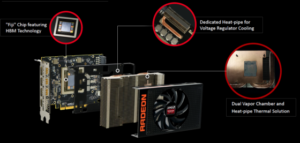AMD has formally announced its Radeon R9 Nano graphics add-in board (AIB), as the latest and most anticipated member of its Fury X series of GPUs. It’s a marvel of technology improvements. according to our friends at Jon Peddie Research. Operating at 175W and requiring only one 8-pin power plug, this killer board is targeted at UltraHD gaming and virtual reality. This is an enthusiast AIB, and is priced accordingly. Selling at $650, it will be available by the second week of September.
AMD says that the Radeon R9 Nano is the fastest Mini-ITX graphics card ever designed to enable UHD gaming in the living room, through ultra-quiet, ultra-compact PC designs. The company previewed it to gamers at E3 in June, and we’ve been waiting for the Nano ever since.
The R9 Nano graphics card is based on the graphics chip codenamed ‘Fiji’. It is the third Fiji-based product to be launched this summer, alongside the AMD Radeon R9 Fury and R9 Fury X. This will be the last GPU AMD offers based on the 28nm HPX process, and the company has squeezed every ounce of performance out of the Fiji while reducing power; it sounds as if they’ve broken some laws of physics, but they did it!
The Radeon R9 Nano features 64 compute units (CU), with 64 stream processors per CU; this works out to a total of 4,096 stream processors, the same as the flagship R9 Fury X. The AIB’s GPU has 256 texture mapping units (TMUs) and 64 raster operation units (ROPS). Compared to the Radeon R9 Fury X, with 8.6 TFlops and a 1,050 MHz GPU clock, the Radeon R9 Nano hits 8.19 TFlops with a 1,000 MHz engine clock. It accomplishes that partially by employing greater memory bandwidth over GDDR5 via a 4,096-bit memory interface. Normally a wide bus width will cost you in power consumption, but AMD came up with some clever low power switches (which it isn’t talking about); AMD has always been clever and a little ahead of the curve when it comes to memory management.
The R9 Nano is the first GPU to deliver AMD’s new 3D stacked 4 GB of HBM VRAM on the main die itself. They run it at 500 MHz (1.0 GHz effective) and that gives the GPU 512 GB/s bandwidth – a scorcher.
By stacking up the memory (on the GPU), lots of board space can be saved, and more efficient cooling can be realised. The net result is a smaller, cooler, less power consuming AIB that goes really fast. The AIB has a tiny heat sink (by GPU standards) and a single, 92mm, single axial fan.
Cooling is not the only part of the equation: the new Nano gets the best performance per Watt and price – check the Pmark scores (JPR’s comparison of price, Wattage, and performance to calculate a products comparative value).
| Radeon R9 Nano | Radeon R9 Fury | Radeon R9 290X | Dual GPU Fury (future AIB) | Radeon R9 Fury X (Water Cooled) | |
| GPU | Fiji XT | Fiji Pro | Hawaii XT | Fiji XT x 2 | Fiji XT |
| Stream Processors | 4096? | 3584 | 2816 | 8192 | 4096 |
| GCN Compute Units | 64? | 56 | 44 | 128 | 64 |
| Render Output Units | 64? | 64 | 64 | 128 | 64 |
| Texture Mapping Units | 256? | 224 | 176 | 512 | 256 |
| GPU Frequency | Up to 1000 MHz | Up to 1000 MHz | 1000Mhz | TBA | Up to 1050Mhz |
| Memory | 4GB HBM | 4GB HBM | 4GB GDDR5 | 8GB HBM (4 GB Per Chip) | 4GB HBM |
| Memory Interface | 4096bit | 4096bit | 512bit | 4096-bit x 2 | 4096bit |
| Memory Frequency | 500Mhz | 500Mhz | 1250Mhz | 500Mhz | 500Mhz |
| Effective Memory Speed | 1Gbps | 1Gbps | 5Gbps | 1Gbps | 1Gbps |
| Memory Bandwidth | 512GB/s | 512GB/s | 320GB/s | 1024 GB/s | 512GB/s |
| Cooling | Air, Single Fan | Air, Custom AIB Solutions | Air, Single Blower Fan | Liquid | Liquid, 120mm Radiator |
| Power | 174 | 275 | 290 | 375 | 275 |
| Performance TFLOPS | 8.19 | 7.2 | 5.6 | 17.2 | 8.6 |
| Price | $649 | $549 | $549 | TBA | $649 |
| Pmark | 72.53 | 47.69 | 35.17 | NA | 48.19 |
| GFLOPS/Watt | 47.07 | 26.18 | 19.31 | 45.87 | 31.27 |
| Power Connectors | 8-Pin | Dual 8-Pin | 6+8 Pin | Dual 8-Pin | Dual 8-Pin |
| Launch Date | 27th August 2015 | 10th July 2015 | 24th October 2013 | Autumn 2015 | 24th June 2015 |
AMD says that the R9 Nano AIB is enabling UHD-class gaming in your living room in an exceptionally quiet, ultra-small design.
Analyst Comment
With 30% more performance and 30% lower power than the previous generation Radeon R9 290X AIB, the 175W Radeon R9 Nano becomes the world’s most power efficient Mini-ITX enthusiast graphics card available – period. This sets a new bar on size and performance. Its price is going to challenge a few users, but in graphics you really do get what you pay for, so we think that this is a good deal if you can afford it. (JP)

